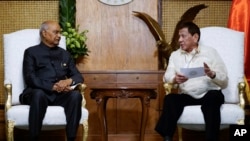The Philippines has agreed to strengthen defense ties with India, an increasingly significant Western ally in Asia, as part of its accumulation of foreign support in case fragile ties with China suddenly break down.
Last week, the presidents of India and the Philippines decided to work more closely together on defense and security in light of what the presidential office in Manila called a “fast-changing geopolitical landscape in the Asia-Pacific region.”
Philippine President Rodrigo Duterte welcomed India’s role in a Philippine program to upgrade defense, the presidential office said in a statement Saturday after a visit by Indian President Ram Nath Kovind.
Duterte, despite warming up to China after taking office in 2016, is now seeking foreign ties elsewhere fearing pressure from Beijing on a maritime sovereignty dispute over the South China Sea.
“He cannot be sure of China’s one-way goodwill,” said Alan Chong, associate professor at the S. Rajaratnam School of International Studies in Singapore. “He thought he had China as a friend. Then I think he realized that behind the smiles and the pageantry and all the economic deals, China was actually continuing to militarize its islands in the South China Sea.”
India has its own grievances with China and has been working with a other countries, including the United States, to check Beijing’s maritime expansion.
China relations
Despite Duterte's efforts to fostered a friendship with Beijing, with China pledging $24 billion in aid and investment to the Philippines in 2016, hundreds of Chinese vessels stirred up concerns after passing near Philippine-held islets in the sea’s contested Spratly archipelago in April.
And, in early June, a Chinese fishing boat sank a Filipino vessel near the disputed sea’s Recto Bank, raising questions about a possible ramming incident.
Duterte is now looking for closer relations with powerful third countries, using China as a gambit, said Stephen Nagy, senior associate politics and international studies professor at International Christian University in Tokyo.
“It’s the Philippines really fishing for lots of different assistance and using China as the bait,” Nagy said. “Unofficially, the Chinese are probably not going to be happy that India has increased their relationship with the Philippines. And they will probably read it as the Philippines basically milking every cow rather than really forging a strong and enduring relationship with China.”
Duterte visited Russia earlier this month for talks that analysts say could generate arms sales. He has made efforts to cozy up to Washington this year after a strain in relations in 2016. And, in May, the president made his third visit to Japan, which like India, is working with Washington and other western countries to check China’s maritime expansion.
“As countries strategically located in the Pacific and Indian Oceans, we affirmed our shared interest to protect our maritime commons and advance the rule of law in our maritime domains,” Duterte said after meeting India's Kovind.
Brunei, China, Malaysia, Taiwan, Vietnam and the Philippines claim all or parts of the sea. China claims 90% of the waterway as its own and it has taken a military lead there over the past decade.
India’s interests
India, located west of the Indochinese peninsula, does not claim any part of the South China Sea, but in September, it held military drills with Japan and the United States outside the South China Sea.
Even though the drills took place outside the disputed sea, India showed support of a “ruled based order” in Asian seas instead of “giving credence to Beijing’s claims,” said Jay Batongbacal, international maritime affairs professor at University of the Philippines.
New Delhi probably sees stronger Philippine defense relations as “complementary” to its ties with Japan and the United States, Nagy said.
India’s Act East policy that calls for stronger economic ties with fast-growing Southeast Asia – including the Philippines – would put further weight behind China’s rivals in the maritime dispute. India is the 15th largest investment partner of the Philippines, according to government data from Manila.
But these ties may not be enough.
“India itself is also in a way still exploring what it can do in Southeast Asia in general based on its Act East policy, but in terms of substance it is also been not moving as fast as say China,” Batongbacal said.







